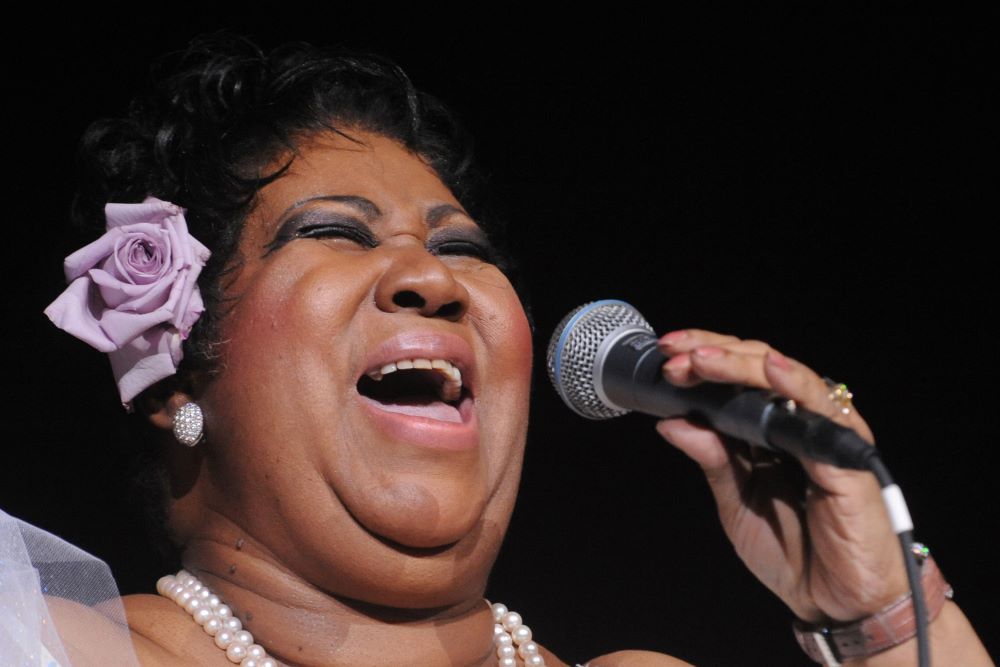
Aretha Franklin performs at a sold-out Radio City Music Hall show March 21, 2008. Franklin released "Young, Gifted and Black" in 1972. She died in 2018. (AP/Henny Ray Abrams)
What we know: Every album can be read as a love album. Every album includes songs that describe a proximity to love or an approximation of what love feels like. (And they're always approximations.)
What we know: "Young, Gifted and Black" is a love album. It turns 50 this year. Aretha Franklin, who died in 2018, recorded it between marriages to Ted White and Glynn Turman. She was married to each man for fewer than 10 years.
What we don't know: Who the love songs on the album written for. (All the king's horses / And all the king's men / Couldn't put our two hearts together again)
What we know: When the album was released in 1972, Ms. Aretha Franklin was 30 years old. She was born to a minister named C.L. Franklin and a mother who left the family when Ms. Franklin was young and died before Aretha's 10th birthday. C.L. Franklin was friends with Dr. Martin Luther King, Sam Cooke and Mahalia Jackson. When just a child herself, Ms. Franklin gave birth to her first son at age 12. Two years later she recorded her first album of gospel songs. Years passed and she worked to move from gospel to pop and soul, though church and holy belief is everywhere in her voice. By the time "Young, Gifted and Black" was released in 1972, Ms. Franklin had released 21 albums, including recordings of live concerts.
The songs she wrote for the album aren't its most powerful love songs. "First Snow in Kokomo" is about the seasons changing, possibly a metaphor for the seasons of our lives, the continuous bending of one season into another. "All The King's Horses" buries a romance. The lyrics borrow from the children's story Humpty Dumpty, which says that the fate of our lives is decided not by what we want for ourselves but by what our bodies predetermine. The love interest of Ms. Franklin isn't present in "Day Dreaming"; it's the image of him she sings of, what they would do together, what she would commit to him to bring him out of the plane of imagination. "Rock Steady," which immediately follows "Day Dreaming" lifts my mood. It cannot be helped but to move the body.
Also: I am still these days. I am pandemic prone. I am disconnected, distrusting and disaggregated I feel in many places. I am wanting, and I am wanting for love that precedes hope.
And: Mahalia Jackson said: "The whole family wanted for love."
What we don't know: What does wanting for love sound like? What will you accept in lieu of love? Will you accept its approximations?
And, how to say: I love you, without saying I love you. Say: It will be OK, all of it, without platitude. Say: I am scared, without sinking into mortality. Say: I want for community, and righteousness, and they are trying to pull me from myself. Say: music. Say: This body has a feeling. Say: It will all turn out OK. As OK as anything in a country can be.
The title song, "(To Be)Young, Gifted and Black," belongs to Nina Simone, who wrote and recorded the song in 1969. The words belong to Lorraine Hansberry, who in 1964, told a group of young students who had won an essay contest, "I wanted to be able to come here and speak with you on this occasion because you are young, gifted and Black."
Ms. Simone said to students at Morehouse College, "I remember getting a feeling in my body, and I said, 'That's it: to be young, gifted and Black. That's all.' And sat down at the piano and made up a tune. It just flowed out of me." It was music to "make Black children all over the world feel good about themselves, forever."
It is a gift to be Black. The giftedness is inherent.
I imagine that all the love songs ever written are a lyric in one giant, incomplete and uncompleteable love song. There is an invisible chain that connects the words of Ms. Franklin to Ms. Simone to Ms. Hansberry to the people who first watched "A Raisin In the Sun" on Broadway to the children of those in the audience to the love songs those children learned in school.
How it is that one woman's gratitude becomes another woman's song, and a few years following, Ms. Franklin transforms spoken words into a ballad. How is it that when repeated the words build in meaning rather than become diffused of it. How is it that words can have a soul.
The words that aren't said also have a soul. These are more sinister. These words taste bitter on the tongue.
Musician Billy Preston once said of Ms. Franklin, "On any given night, when that lady sits down at the piano and gets her body and soul all over some righteous song, she'll scare the shit out of you." To be moved by her music is to be reminded of one's own humanness.
Where does the soul sleep? What wakes the soul from its deep slumber? When sorrow and numbness bury themselves in my bones, Ms. Aretha Franklin's voice pulls me out from myself. Pulls out my soul that is.
Advertisement
On most days we move through the world in a liminal space. We transient. Mind alive body numbed. Being unalive in a ticking body is like living with a ghost. And when that ghost is you, you bear the realization that it is possible to have been about the world without looking at it. You understand how it is that entrapment in a breathing body is not analogous to living, even while living in a body does require breath.
You can disappear from yourself without even realizing it.
What we know: Day dreamin' and I'm thinkin' of you Day dreamin' and I'm thinkin' of you Day dreamin' and I'm thinkin' of you Day dreamin' and I'm thinkin' of you
Love awakens the soul. Love places the soul back in the body. Music does too.
Let's get away from ourselves let's go somewhere far and fall in love.




